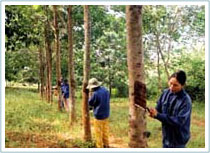Fertilizing for rubber
At the basic construction stage (KTCB), rubber trees (CS) need nutrition to develop roots, stems, branches and leaves. In the condition of adequate nutrients, plants grow quickly, shortening the time of economic development.
Nutritional needs of rubber trees:
- At the business stage (KD), the tree has just grown and produces latex, fruit, and seeds must be replaced every year. When fully supplied with nutrients, the plant will have a good canopy, creating high photosynthesis to help plants grow fast, resist pests and produce high yields. Although nutrient removal by product is not much, nutritional needs for plants grow and develop quite high. To give 3 tons of latex / ha / year, the rubber tree sucked away 18.9 kg N, 3.8 kg P 2 O 5 , 12.9 kg K 2 O. However, when stimulant was used, the yield was also 3 tons of plant nutrients removed by latex yield was 18.9 kg N, 8.7 kg P2O5, 15.5 kg K 2 O.
- Protein is a very important nutritional factor, playing a role in creating productivity and quality. Lan has an important role with rubber trees, however, the ability to absorb phosphorus at the stage of young trees is weak, improved when the trees mature. Potassium plays an important role in the growth, development and latex yield of rubber.
- In addition to the macronutrients, rubber trees absorb a lot of mediums such as calcium, magnesium, sulfur and trace elements such as manganese, iron, boron, molybdenum, zinc, copper.
Nutritional supply of rubber trees:
 Rubber growing soil is a storehouse of nutrients for plants and an intermediate environment for putting nutrients into plants. Nutrients in soil are usually in two forms, organic and inorganic. Helping farmers facilitate fertilizer application, Binh Dien Fertilizer Company would like to introduce specialized fertilizer products for rubber trees:
Rubber growing soil is a storehouse of nutrients for plants and an intermediate environment for putting nutrients into plants. Nutrients in soil are usually in two forms, organic and inorganic. Helping farmers facilitate fertilizer application, Binh Dien Fertilizer Company would like to introduce specialized fertilizer products for rubber trees:
The Head Buffalo microorganism has the effect of providing the organic matter and the micro-organism needed to stimulate the microorganisms in the soil to grow and develop. NPK 20-20-15 + TE Head Buffalo with high levels of nitrogen and phosphorus, helps rubber industry to develop quickly and strongly switch to the trading stage. In particular, specialized buffalo head used rubber buffalo, with nutritional composition of 20% N, 10% P 2 O 5 , 15% K 2 O; 0.75% CaO, 0.5% Mg and medium micro-substances help KD rubber grow and thrive, prevent falls, give more latex, improve productivity, increase profits and increase fertility land.
Fertilizing for rubber:
Rubber KTCB: 300 - 500 kg NPK 20-20-15 + TE Buffalo Head or NPK 16-16-8-13S Buffalo Head + 3 - 5 tons of Buffalo Head microorganism / ha / year.
Rubber KD: 500-800 kg Buffalo Head rubber + 5 - 10 tons of First Buffalo micro-quantity / ha / year. Depending on the growing conditions of the tree, the exploitation of latex, after each harvest, to adjust the fertilizer accordingly. The amount of fertilizer is divided into 2-3 times at the beginning, middle and end of the rainy season. Applying band width 0.5 - 1.0 m between two rows of rubber. Clear grass, leaves, and ditches 10 - 15 cm deep, then fill up the soil or leave the leaves to seal.
According to the Informatics Center of the Ministry of Agriculture and Rural Development, Agricultural Science and Technology
- Techniques for fertilizing ornamental plants, ornamental flowers
- Multipurpose automatic fertilizer machine for rubber
- What does rubber molecule have to do with mass migration?
- Guayule - An easy-growing shrub for pure rubber latex to make tires of future vehicles
- Video: Stun with a full process 'hardship' to create a rubber band
- How is rubber 'vastly elastic'?
- New research reveals a method to increase rubber latex production
- Rubber razor assembled
- Making rubber from dandelions
- New products from waste rubber sources
- Dropping a rubber duck into a bathtub to play is more dangerous than you think
- Flexible rubber keypad, programmable keypad
 'Barefoot engineer' invents a pipeless pump
'Barefoot engineer' invents a pipeless pump Process of handling dead pigs due to disease
Process of handling dead pigs due to disease Radiometer
Radiometer Warp Engine: Technology brings us closer to the speed of light
Warp Engine: Technology brings us closer to the speed of light